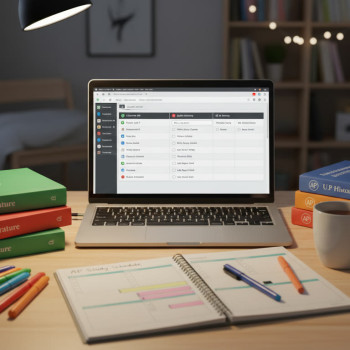Introduction: Why a Google Sheets AP Planner Actually Works
If you’re juggling multiple AP classes, practice exams, extracurriculars, and a life that doesn’t pause for study blocks, a little structure goes a very long way. Google Sheets is quietly brilliant for AP prep: it’s flexible, shareable with teachers or tutors, and powerful enough to become a living dashboard for your progress. This article walks you step-by-step through building a Score & Time Tracker that turns raw effort into measurable improvement — and keeps you calm as the exam season approaches.

What This Planner Gives You
Think of the Google Sheets AP Planner as your personal mission control. When built right, it helps you:
- Track practice scores and identify weak topics fast.
- Plan realistic weekly study blocks and visualize time spent.
- Set target scores and reverse-engineer a study roadmap.
- See trends across time — so you study smarter, not just harder.
- Share progress with teachers, parents, or a tutor for targeted feedback.
Getting Started: The Essential Sheets You’ll Create
Start by making a single Google Sheet with multiple tabs. Each tab has a specific job — together they form an ecosystem that supports planning, practice, reflection, and iteration.
- Overview Dashboard — One-page snapshot of targets, current composite scores, average time per week, and a mini calendar of upcoming practice tests.
- Score Tracker — Record every practice test, section score, date taken, and notes about question types missed.
- Time Log — Log study sessions by date, start/end time, activity (e.g., multiple choice, FRQ practice, flashcards), and focus level.
- Topic Mastery — A table of course topics with mastery levels (0–100%) and evidence for each level (practice problems, past quiz scores).
- Weekly Plan — A simple weekly calendar where study blocks are scheduled and color-coded by priority.
- Notes & Resources — Quick links (URLs or document titles), AP Classroom tasks, and personalized homework from teachers or tutors like Sparkl.
Why Separate Score and Time?
Scores tell you outcomes; time tells you inputs. Separating them lets you correlate hours invested with score gains — the most actionable insight for improving efficiency. You might discover that three targeted 45-minute sessions a week beat one marathon cram session.
Designing the Score Tracker Tab
This tab should feel like an accountable scoreboard. Every entry is a data point for patterns you’ll use to adjust study tactics.
Columns to Include
- Date
- Practice Test Name (e.g., College Board AP Practice Exam 3)
- Section (MC, FRQ, Lab, etc.)
- Raw Score
- Scaled/Estimated AP Score (1–5)
- Time Spent on Review (minutes)
- Top Errors (brief notes)
- Confidence Level (1–5)
Formula Tips
Use formulas to auto-calculate averages and trends. Example: AVERAGE for raw scores, TREND or SLOPE to compute recent momentum, and conditional formatting to highlight sliding windows where scores dip below your target. Color-coding cells — red for below target, yellow for near target, green for on-track — creates immediate visual cues.
Designing the Time Log Tab
This is your “study time bank.” It doesn’t need to be perfect — just honest. Logging small details makes reflection easier: did active recall sessions outperform passive reading? The Time Log answers that.
Columns to Capture
- Date
- Start Time / End Time
- Duration (minutes) — computed
- Activity Type (Practice Test, FRQ Review, Flashcards, Video Lesson)
- Focus Rating (1–5)
- Outcome / Note
Topic Mastery: Turning Errors into Action
Track individual topics (straight from your course outline or AP Course and Exam Description): for example, in AP Biology you’d have Evolution, Cellular Energetics, Information Transfer, etc. Assign a mastery percentage and evidence source: quiz score, targeted practice, lab write-up. Over time, these percentages should guide your weekly plan: lowest mastery = highest priority.
Sample Topic Mastery Table
| Topic | Mastery % | Last Evidence | Next Action |
|---|---|---|---|
| Photosynthesis / Cellular Respiration | 62% | Quiz 4: 7/12 correct | 2 targeted problem sets, 30-min concept map |
| Experimental Design | 84% | Lab write-up A: 92% | 1 timed FRQ on experiment analysis |
| Genetics | 73% | Practice Exam 2 MC section: 14/25 | Review punnett squares, spaced retrieval |
This table gives a snapshot of what to push this week and how to prioritize sessions in the Weekly Plan.
Weekly Plan Tab: Scheduling with Purpose
Scheduling isn’t about rigid perfection — it’s about creating predictable, repeatable study rhythms. Block your calendar in 30–90 minute chunks, alternating focused practice with active review.
Sample Weekly Block Ideas
- Monday: 45 minutes — Topic Drill (weakest topic)
- Tuesday: 60 minutes — Full Section Practice (timed MC)
- Wednesday: 30 minutes — Flashcards + Mistake Review
- Thursday: 75 minutes — FRQ practice and rubric walkthrough
- Friday: 20 minutes — Light review + plan adjustments
- Weekend: 120 minutes — Full practice test (simulate testing conditions)
Tag each block with an objective (e.g., “Target: 80% accuracy on AP Physics 1 MC”) so when you open a block you know what success looks like.
Visuals and Charts That Make Data Useful
Don’t underestimate charts. A simple line chart of practice score vs. date, combined with a stacked bar chart for weekly hours by activity type, reveals what actually moves the needle.
Suggested Charts
- Score Over Time (line chart) — shows momentum and test-day readiness.
- Hours by Activity (stacked bar) — reveals where your time goes.
- Topic Mastery Heatmap (conditional formatting) — highlights focus areas.
Example Dashboard Layout
A tidy dashboard fits on one screen: top-left shows target AP score vs. current; top-right shows next 4 weeks of scheduled sessions; middle displays score trend; bottom shows a quick to-do list pulled from Topic Mastery. Use named ranges and IMPORTRANGE if you split data across multiple sheets for cleaner formulas.
How to Set Realistic Targets and Milestones
Setting targets is a bit of art and a bit of math. Start with a baseline — your last practice exam — and add realistic increments. If you scored a projected 3 and want a 4, identify the sections where the most points are won. Often, improving one or two weak subtopics or reducing careless mistakes yields the biggest jump.
Milestone Example
| Milestone | Target Date | Metric | Action |
|---|---|---|---|
| Baseline Assessment | Six weeks before exam | Practice exam score | Full timed practice test |
| Midpoint Check | Three weeks before exam | Average of two timed sections | Two timed section practice sessions + review |
| Final Dress Rehearsal | One week before exam | Simulated full exam | Strict timing, full protocols, light review afterwards |
Active Study Techniques to Power the Planner
The planner is only as good as what you do inside it. Here are techniques that consistently convert time into higher scores.
- Active Recall: Close the notes and write or speak answers from memory.
- Spaced Repetition: Revisit weak facts at expanding intervals.
- Practice Under Conditions: Simulate exam timing and environment for at least one full practice test per week in the final month.
- Error Logs: Log every missed question with why you missed it and what you’ll do next time.
- Rubric-Driven FRQ Practice: Use rubrics to self-score and to guide improvements.
Using the Planner with a Tutor or Teacher
Sharing your Sheet with a teacher, counselor, or tutor creates accountability and makes feedback targeted. If you’re working with Sparkl’s personalized tutoring, for example, your tutor can access the tracker to design 1-on-1 sessions that address the exact topics where you’re losing points, craft tailored study plans, and use AI-driven insights to recommend practice materials. This makes tutoring time genuinely catalytic instead of generic.
How to Run a Weekly Review (15–30 minutes)
Every week, open the planner and run a review. This short ritual is where strategy trumps effort.
- Look at score trends: which sections improved and which didn’t?
- Check Time Log: did high-focus sessions correspond with gains?
- Update Topic Mastery with new evidence.
- Adjust next week’s blocks based on the highest-priority weaknesses.
- Set one specific behavioral goal for the week (e.g., “no phone during study blocks”).
Example Case Study: How 8 Weeks Turned a 3 into a 4
Emma was taking AP United States History. On her first full practice test eight weeks out she scored a projected 3. She used the planner to:
- Log each missed LEQ and categorize errors (evidence, reasoning, synthesis).
- Schedule three 45-minute sessions weekly focused solely on writing practice with rubric checks.
- Record time spent reviewing teacher feedback on essays (not just writing them).
By week four, her average LEQ rubric score rose by 1 point; by week eight her composite practice score moved from a 3 to a 4. Small, consistent sessions plus targeted feedback were the multiplier. Emma’s tutor used her shared planner to assign tailored prompts and monitor progress between sessions, maximizing the value of each 1-on-1.
Pro Tips and Shortcuts in Google Sheets
- Use Data Validation to create dropdowns for Activity Type or Topic — consistency makes charts accurate.
- Protect cells that contain formulas so you don’t accidentally overwrite them during updates.
- Use the Query function to build filtered views (for example, show only entries from the last 30 days).
- Leverage conditional formatting for quick visual triage (e.g., highlight any topic under 70% mastery in red).
- Set up an automatic weekly email summary using Google Apps Script if you want a push reminder of progress.
Common Mistakes to Avoid
- Logging hours but not linking them to outcomes — time without reflection is busywork.
- Over-scheduling long, unstructured sessions — short, targeted work often wins.
- Ignoring small errors — careless mistakes repeat unless tracked and fixed.
- Relying only on practice tests without mixing in micro-practice and spaced review.
Preparing for Exam Week with Your Planner
Two weeks out, reduce new learning and prioritize consolidation. Use your planner to:
- Schedule lighter study blocks focused on weak spots (30–45 minutes).
- Run one full, timed practice exam under test-like conditions and one lighter review day.
- Log sleep and nutrition as part of the Time Log: good rest correlates with performance.
- Run a pre-exam checklist (admission ticket, permitted calculator, school policies).
How to Measure Success Beyond the Score
AP prep isn’t just about a number on a scale. Use the planner to measure:
- Consistency: Did you hit planned study blocks most weeks?
- Quality of Practice: Were sessions high-focus or distracted?
- Confidence: Does your self-rated confidence move in tandem with scores?
- Transferable Skills: Are your analytical writing and time management improving?
Sharing Data While Protecting Your Privacy
If you share the planner with a tutor, teacher, or parent, consider making a view-only copy for them or remove sensitive notes. Google Sheets lets you control access and create copies for different audiences easily.

Templates and Next Steps
Start simple. Create the tabs above and fill your first week with honest entries. If you partner with a tutor — for instance through Sparkl’s personalized tutoring — ask them to review your planner and propose a tailored study schedule. Combining data-driven planning with expert 1-on-1 guidance shortens the path to improvement.
Final Checklist Before Exam Day
- One full timed practice exam completed within two weeks of the test.
- Topic Mastery updated and top three weaknesses scheduled for light review only.
- Sleeping and eating routine set for exam week.
- Log of practice performance showing upward trend or stabilized at target level.
- Exam logistics confirmed with AP coordinator (date, time, room, allowed materials).
Wrapping Up: Make the Planner Yours
A Google Sheets AP Planner is not a one-size-fits-all product — it’s a framework. Customize the tabs, the metrics, the charts, and the cadence so it reflects how you study best. The moment you stop guessing and start measuring, you’ll find your study time becoming more meaningful and more effective. And when you combine that clarity with tailored support — whether that’s a teacher’s weekly check-ins or Sparkl’s targeted 1-on-1 tutoring and AI-driven insights — the gains compound quickly. Build the planner, iterate every week, and remember: steady, focused effort beats frantic cramming every time.
Quick Start To-Do (15 Minutes)
- Create a new Google Sheet and make tabs: Dashboard, Score Tracker, Time Log, Topic Mastery, Weekly Plan, Notes.
- Enter your last full practice test score and one topic you struggled with most.
- Schedule three study blocks for this week (45–60 minutes each) and log them in Weekly Plan.
- Share the Sheet in view-only mode with your teacher or tutor if you want feedback.
Good luck — you’ve got strategy, structure, and a system. Use them, adapt them, and let the data guide your next move. The AP exam is a marathon of skill and strategy; with a Google Sheets Score & Time Tracker, you’ll run it with a plan, not hope.



















No Comments
Leave a comment Cancel